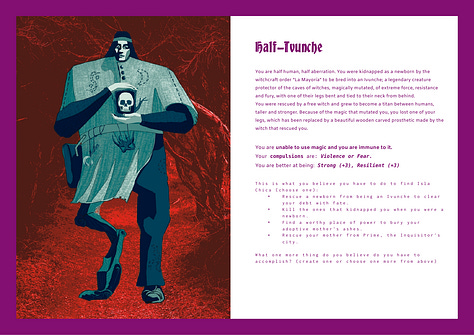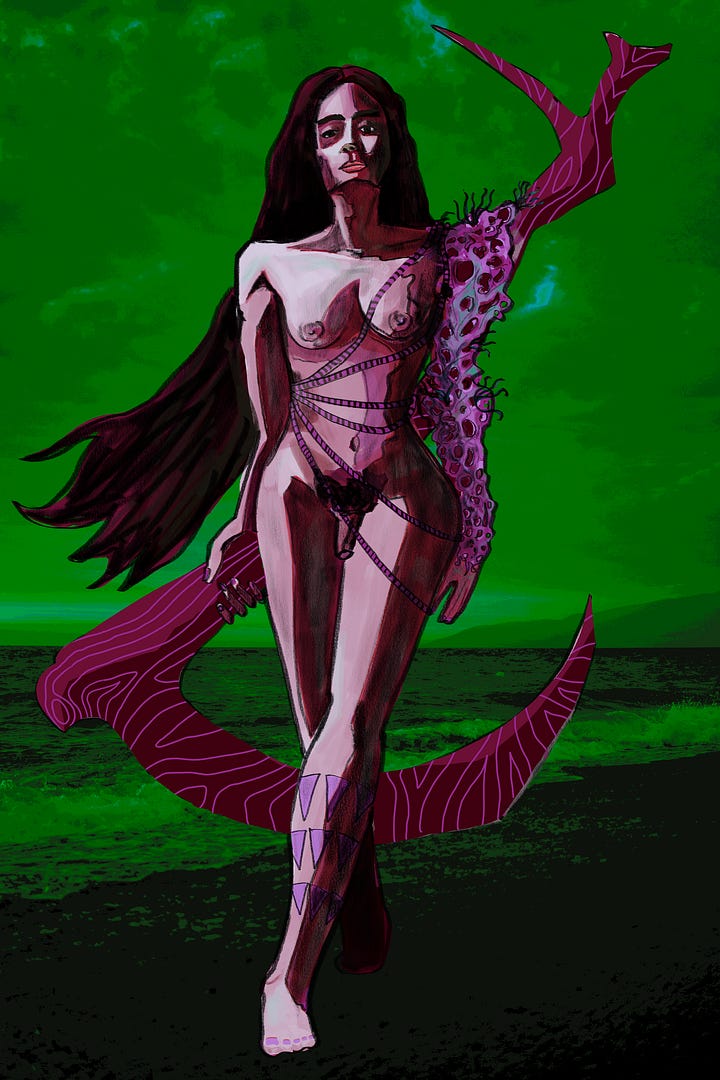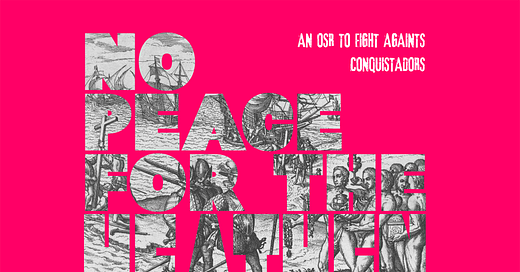In this post, I want to give you an idea of how are the things going with “No Peace for the Heathen” (NPFTH), by showing you an outline of what you will find in it.
In general terms, the game is going fine. However, it has taken much more time than what I anticipated.
I started this game as a short final project before getting deep into some work I’m doing with some collaborators. It was meant to be a last feel-good, endorphin releaser, fulfilled goal (“The Promised Ones”, on the other hand, is a project I want to give more time to mature and develop), but it became something a little more time-consuming but also more interesting and fun.
To date, the rules of NPFTH are all written, the tables are almost all done, except for roughly 10% of them that are related to the locations of Prime and Port Salvation (both cities of Conquistadors and Inquisitors). Additionally, I still have to write at least one starting scenario (I was planing to write three of them, one for each region on the map, but for time constrains I may have to settle with one only) and finish the “bestiary”.
So what would be inside NPFTH?
The things you will find inside NPFTH
Introduction to the game, sharp and short.
A map and an outline of locations on Isla Grande.
Rules for earthquakes and geological disaster (something very common in this region of the world).
Rules to evolve, from session to session, the dominion that colonist have over the island and a set of consequences to represent their influence over the inhabitants of the island.
Six “Dramatis Personae” for players to choose from (i.e. the classes of the game). They include background, mechanical particularities, compulsions, and objectives.






Ten backgrounds for the relationships between players characters (PCs), with questions so they can specify their relationship inside these ten options.
Eight prompts with questions about what had happened in the last month to the PCs. To use as a device to start an adventure.
Guide to “Sign of the skin” and “Marks of the fungi nests”, two additional aspects of the past of the PCs that could have some tangible effects on their bodies.
How do you do things? (the main resolution mechanics)
d20 + “Tactic” (stats) vs DC.
The tactics are: Strong, Resilient, Agile, Sneaky, Imposing and Observant, with values between 0 and 10. When creating a character, you have 6 points to distribute among your tactics.
You can roll with advantage/disadvantage (roll 2d20 and use the best/worst result) when doing things following/against your compulsion.
Plus a simple method to use the difference between the rolls and the DC to determine the loss of Blood (HP) when failing in dangerous situations.
Blood (HP) → The size of your pool of Blood initially is 3d6 + Resilient.
Blood has five tints, Blue, Black, Red, Green, and White.
Blood of each one of these tints can be expended to modify roles made with a particular tactic → Strong can be feed from red, Resilient from green, Agile from blue, Sneaky from black, Imposing from red, Observant from green. White feeds nothing.
Rules for item slots → you have 10 + Strong item slots.
Weapon, shield, and armour:
I recently updated the method of random selection of weapons and shields. Before, it was just a simple role, where each item had the same probability of being chosen. Now, they are arranged such that the less powerful items are the more probable of being selected by rolling two dice, but players can make a trade to modify this role by loosing a permanent point in any tactic.
Armour follows the Mork Borg style of armour, also used by other games, where armour is represented by a die that when rolled absorbs damage. In NPFTH if you roll a 1 in armour die, the armour deteriorates, and the die steps down one tier (d8 → d6 → d4 → broken).
Grief and Dominance, this two were later additions and were born out of necessity to give more interesting options to the narrative mode of combat.
Also, I included Grief and Dominance so that the game had a system of earning XP that allowed PCs to increase their proficiency in exerting violence, but which made them more vulnerable to Vice Incarnated and Sentient Relics (horrifying magically-twisted creatures that embody the religious madness of those who have come to exterminate them).

Rules for languages and the Chasm (gap that lies between the world views of the invaders of the north and the people of Isla Grande, from here magical energies emerge to twist reality). These rules give an overview of the language that the people of the island speak, and each one of them allows them to speak with another kind of being.
Werid Paraphernalia → 60 random magical items.
Rest and recovery of blood
By eating → restore your blood: 1 point eating raw, 2d4 points if you cook.
By catching your breath → restore d4 of blood (White tint).
By sleeping → restore 2d6 of blood (Red tint).
Conditions.
This is a simple method of getting “mechanically impacted” without loosing Blood.
Conditions use Item Slots,
They give negative modifiers to rolls (example, shaken -1, charmed -2, etc…)
Deathly experience → i.e. the conditions of dead in the game.
This is based on Mork Borg, but I have made it so that deathly experiences are more probable than absolute death, to have more fun with the scars and consequences that deathly experience leave on characters.
12 Spirits of the land and rules to call for their aid → this is a revised version of my take on divine magic. It is accessible to all PCs (you just have to make a rite of calling to ask for the favour of the spirits of the land) but it is less reliable than the classic divine magic of other games.
Blood and Food → how to change the tint of your blood by eating different food, this is my homebrew to make cooking and hunting more of a central part of the game loop.
Food and their colours.
Sneak to kill → this is just an addition that I realized it was missing in some of the games I have played. It is a simple rule that allows you to sneak in someone and just kill them, regardless of how “powerful” they are. If you're good enough at sneaking, then it is your decision if they die, plain and simple. Even when your victim is someone with a huge pool of Blood (HP), if they are caught sleeping, and you cut their neck, they are done.
Killing in combat → this is the section of, yes, combat.
Uses rolls in opposition.
The difference between the rolls is the damage you do, or you receive (you can get damaged while attacking).
It is designed to be lethal and fast, you can attack as much as you like until you get damaged in one of your attacks by your victim.
Here you will also find Modes of combat → narrative (that uses dominance as a narrative token of combat superiority) and tactical (based on skirmish games, used when at least one PCs is commanding a war-band).
How to get better at killing, tactics and get more blood → this is the “how to level up” part of the game. But it has different options depending on what is the thing you want to improve. You have:
War tactics → to increase your war-band abilities in tactical combat.
Advancing on tactics and blood pool size → by answering questions at the end of an adventure or when killing a mighty foe, or whenever the GM feels is appropriate.
Witchcraft, the five secrets of “La Mayoria”. → this is the magic system of the game, it is an extension of my homebrew for blood magic, and is inspired by the historical witch society of Chiloé, “La Mayoría”.
Magic can be learnt by anyone. However, “secrets” (spells) are kept by this society of witches, so you have to pass some trials and make some favours to the society if you want their secrets. Except if you play as an Exile Witch, then you already know all their secrets.
People, Places, Invaders, and Terrors; this is the part with tables and more tables for the people of the island and colonists, the main locations, and some dangers that lure the land. The idea of this collection of tables is that they have enough space for creativity, but the setting can be seen through the specificity of the entries on them.
Here I also compiled a set of guidelines and recipes to create the “dungeon-like” locations where Vice Incarnated and Sentient Relic hide; Dead Holy Wheeled Towns.
Exploring the land → rules for encounters with armies of colonists fighting for territory (they are fighting each other all the time, and these skirmishes and larger scale confrontations are part of the landscape).
Three tangled tales to get lost in, and probably die for → the three starter scenarios.
Twisted horrors of the possessed → collection of Vice Incarnated, Sentient Relics, and Colonist Spirits.
Also, here it is included a section for “Feeding Grief to a weapon” → rules to increase the power of specific weapons when killing Vice Incarnated and decrease your Grief.
Legends of the land → collection of creatures inspired by the folklore of Chiloé.
Who will find Isla Chica? → a section for the GM, to guide them on how to navigate the tales of a group of people that are trying to survive and find a way out from the brutality brought by colonists.
Art
So that’s all, until today, inside NPFTH. As I told you before, almost all of it is ready, and also some of the art, which I have separated into three “types”:
Color art for “Dramatis Personae” (PCs “classes”)


Black and white high contrast art for Conquistadors, Inquisitors, and separation of sections.
Sketchy art for creatures, which work more as an in-world perspective.




My expectations
For what I expect for the game, well, it may sound obvious, but I want for the game to be played by more people. The thing is how to accomplish that. I have been thinking of teaming up with someone else to have more reach, or maybe launch a Kickstarter (these are not mutually exclusive options), or who knows, perhaps one of you have a better idea to make this game reach more people (if you have it, please, I really want to hear it, and I’m always open to collabs).
But if I’m a little more ambitious, I would also love for this game to i) give more space in the world of fantasy to the folklore of my country, ii) to present a setting that evokes the horrors of colonization through the lens of fantasy-horror, and iii) to turn around the position that PCs usually take on fantasy games, by putting them in the place of those that are under the threat of being colonized (instead of being the explorers and colonizers of new spaces).
While these are the things I want the game to achieve and communicate, I would have to wait for more people to play it to see if it achieves them, even if only minimally.






